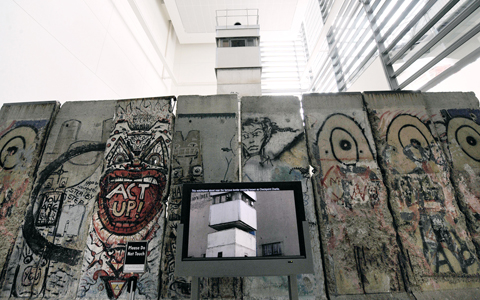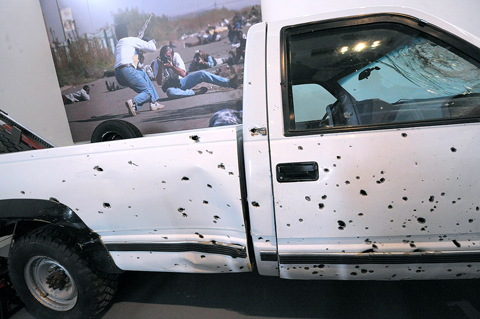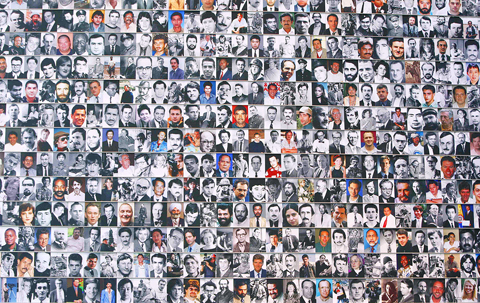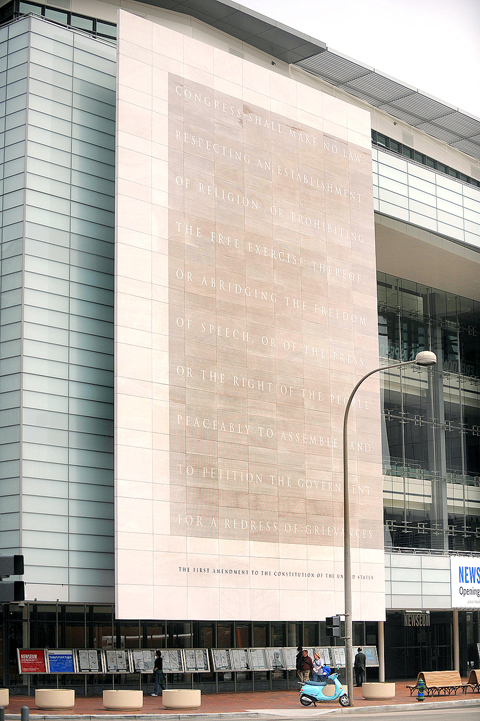When his plane crashed in December 1994, Hitoshi Numasawa, the Nairobi correspondent for Kyodo news service, was on his way to cover one of the first foreign deployments of Japanese soldiers since the end of World War II.
The troops were headed to a humanitarian mission in the refugee camps in Goma, in the former Zaire, where tens of thousands of Hutu killers and their families fled after the Rwanda genocide.
On board the plane out of Nairobi's Wilson Airport with Hitoshi were Toshihiko Irie, Cairo bureau chief for Fuji Television, and Fuji's Egyptian cameraman, Nader Habib.

PHOTO: AFP
Their names are now on a 12m-high wall of glass panels that lists the 1,843 known journalists who have died on assignment around the world.
The wall was dedicated last week as part of Washington's newest museum, the Newseum, which is to open Friday.
Really, it's a reopening.

PHOTO: AFP
The Newseum first opened in 1997 in a Washington suburb, only to close the original site in 2002 in preparation for a relocation to the capital's most prestigious address - Pennsylvania Avenue, the 5km promenade from Capitol Hill to the White House.
The Newseum's new location near the US Capitol is a statement about the role of a free press in American democracy. But more than that, the Newseum and its vast, interactive exhibits encompass the global media - and its heroes.
Newseum chief executive Charles Overby last week called the Journalists' Memorial "the heart of the museum."

PHOTO: AFP
The memorial occupies a remote corner of the modern glass-and-steel structure, but buzzing within earshot are displays with video footage of Martin Luther King Jr's "I have a dream" speech and the suicide strikes on the World Trade Center.
In the basement of the six-story structure is what the Newseum claims is the largest piece of the graffiti-covered Berlin Wall outside of Germany.
The point of the display is that radio and television broadcasts kept the hope of freedom alive behind the Iron Curtain, despite the Soviet regime's best efforts to jam the flow.

PHOTO: AFP
On a different floor, the history of news includes original "news books" that were published after Johannes Gutenberg's invention of moveable type in the mid-1400s.
The visitor can pull out sealed glass trays containing these very first newspapers, including two that give conflicting accounts of the 1588 Spanish naval debacle that gave Britain primacy over the high seas. Even in those days, readers needed multiple sources to get the full picture.
For inveterate fans of old-fashioned newspapers, which pundits have declared a doomed victim of the Internet, the Newseum offers hope: All along the entire Pennsylvania Avenue outside wall hang the day's front pages from mainly US newspapers.
The very top floor - where the terrace gives a spectacular glimpse of Washington's most famous landmarks - offers an even more international wellspring of hope for ink on paper.
Hanging inside are the day's front pages from countries as far flung as Estonia (Eesti Paevaleht Postimees) and Taiwan (United Daily News) - printed out in full color.
The front pages reflect the local and regional imprint: The Namibian's lead headline last Friday was "Mugabe holds Zim Hostage"; the Jerusalem Post featured "Israel assures Syria"; the Guardian carried a banner headline on model Naomi Campbell's arrest at Heathrow Airport; and Turkey's Sabah splashed a huge soccer story across its front page.
The fallibility of news as the first draft of history even gets a place in the Newseum - in the bathrooms!
Set into the walls of the ladies' room were such bloopers as "First female marines train for combat with men" from the Newton, Iowa, Daily News, and "Water parasite fears move to Alberta" from the Province, a Canadian daily in Vancouver.

One of the biggest sore spots in Taiwan’s historical friendship with the US came in 1979 when US president Jimmy Carter broke off formal diplomatic relations with Taiwan’s Republic of China (ROC) government so that the US could establish relations with the People’s Republic of China (PRC). Taiwan’s derecognition came purely at China’s insistence, and the US took the deal. Retired American diplomat John Tkacik, who for almost decade surrounding that schism, from 1974 to 1982, worked in embassies in Taipei and Beijing and at the Taiwan Desk in Washington DC, recently argued in the Taipei Times that “President Carter’s derecognition

This year will go down in the history books. Taiwan faces enormous turmoil and uncertainty in the coming months. Which political parties are in a good position to handle big changes? All of the main parties are beset with challenges. Taking stock, this column examined the Taiwan People’s Party (TPP) (“Huang Kuo-chang’s choking the life out of the TPP,” May 28, page 12), the Democratic Progressive Party (DPP) (“Challenges amid choppy waters for the DPP,” June 14, page 12) and the Chinese Nationalist Party (KMT) (“KMT struggles to seize opportunities as ‘interesting times’ loom,” June 20, page 11). Times like these can

JUNE 30 to JULY 6 After being routed by the Japanese in the bloody battle of Baguashan (八卦山), Hsu Hsiang (徐驤) and a handful of surviving Hakka fighters sped toward Tainan. There, he would meet with Liu Yung-fu (劉永福), leader of the Black Flag Army who had assumed control of the resisting Republic of Formosa after its president and vice-president fled to China. Hsu, who had been fighting non-stop for over two months from Taoyuan to Changhua, was reportedly injured and exhausted. As the story goes, Liu advised that Hsu take shelter in China to recover and regroup, but Hsu steadfastly

You can tell a lot about a generation from the contents of their cool box: nowadays the barbecue ice bucket is likely to be filled with hard seltzers, non-alcoholic beers and fluorescent BuzzBallz — a particular favorite among Gen Z. Two decades ago, it was WKD, Bacardi Breezers and the odd Smirnoff Ice bobbing in a puddle of melted ice. And while nostalgia may have brought back some alcopops, the new wave of ready-to-drink (RTD) options look and taste noticeably different. It is not just the drinks that have changed, but drinking habits too, driven in part by more health-conscious consumers and